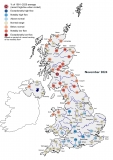Submitted by Steve Turner on
November was a cold, generally settled month and, with the exception of one stormy interlude, frequently under the influence of high pressure. The majority of substantial rainfall occurred within an unsettled three‑day period mid-month, outside of which notable falls were relatively uncommon. Nevertheless, these totals were sufficient for most of England to register above average rainfall. For the rest of the UK, rainfall was notably below average under predominantly anticyclonic conditions, the culmination of a dry autumn for much of the country. Notably high river flows were registered during the stormy interlude mid-month, particularly in south-west England and the Scottish Borders, resulting in fluvial flooding and substantial disruption to transport networks. Despite this, average river flows for November were markedly below average across most of Northern Ireland and western Britain and generally within the normal range elsewhere. Groundwater levels generally continued their seasonal recession in early November although some boreholes responded rapidly to heavy rainfall mid-month. Although reservoir stocks for England & Wales were near average for November, some individual impoundments were substantially below average; stocks for Ardingly and Wimbleball were more than 20% below average, and Clatworthy similarly despite doubling its stocks during November. In Northern Ireland and parts of western Scotland, stocks fell relative to average and were around 15% below average. Whilst the water resources situation remains favourable overall, below average reservoir stocks in certain areas of the UK and the continued delay in aquifer recharge necessitate vigilance, particularly in light of seasonal outlooks which suggest drier weather is more likely than wetter weather for at least the early part of winter.
The full Hydrological Summary can be found here.



